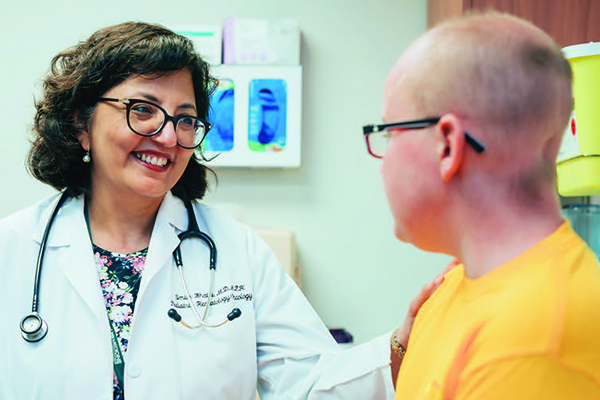What Happens After Cancer is Gone?
Story by Matt Windsor | Photos by Dustin Massey

In 2004, Smita Bhatia, M.D. MPH, established a groundbreaking cohort of cancer patients at the City of Hope cancer center in Duarte, California. She followed up with the patients after blood or marrow transplant and met with them at regular time points — 6 months and 1, 2 and 3 years — to measure their cognitive function on extensive, standardized paper-based tests.
When Bhatia and her husband, Ravi, were recruited to UAB in 2014, Bhatia founded the Institute for Cancer Outcomes and Survivorship. In 2019, Bhatia received a $6.38 million grant from the NIH to create a cohort of more than 10,000 patients treated with blood or marrow transplants between 1974 and 2014, the largest ever studied. The grant will also create a cohort of 3,000 patients treated with conventional therapy without BMT. Patients will include those treated at three sites: UAB, City of Hope and the University of Minnesota.
Cancer research has traditionally focused on killing the disease. Bhatia is a pioneer in proposing the next question entirely: What happens to patients once cancer has gone? Her studies have identified a host of long-term consequences in children and adults after cancer treatment. Understanding these outcomes lets health care providers develop plans to watch out for trouble on the horizon, including accelerated aging, a higher risk of cardiac problems in people treated for cancer as children, and an increased risk of breast cancer in adolescent girls exposed to chest radiation for the treatment of Hodgkin’s lymphoma.
A survey of patients found that only a third realized they were at risk for these late effects of cancer treatment.That is because the family practitioners and internists who are seeing these patients do not encounter cancer survivors very often, so “it is not in the forefront in terms of their understanding, in terms of their knowledge base and in terms of their experience of what they should anticipate,” Bhatia explained. Addressing this situation becomes even more urgent as the number of survivors grows, she adds. “The number of cancer survivors is growing at the rate of about 2 percent every year,” Bhatia says. “We will, by about 2022, have 18 million cancer survivors.”
At City of Hope and UAB, Bhatia has established survivorship clinics specializing in a range of cancer types. At UAB, this includes the Taking on Life after Cancer Clinic at Children’s of Alabama hospital and the Next Steps clinic for breast cancer survivors.
Bhatia’s work attracted Noha Sharafeldin to Birmingham in 2015 to do a postdoctoral fellowship in Bhatia’s lab. “She is a pioneer in this field and an excellent mentor,” Sharafeldin says. “This whole program is focused on identifying patients at risk and targeting interventions to them. That’s our guiding theme.”
Share a Memory of the O'Neal Cancer Center
If you’re a physician, nurse, researcher, trainee, staff member, administrator or volunteer at the O’Neal Comprehensive Cancer Center at UAB, our communications team wants to know what you think is most interesting, pivotal, or noteworthy about the O’Neal Cancer Center’s last 50 years. Submit a memory in honor of the Cancer Center’s 50th anniversary, and we may share it in our social media channels!




